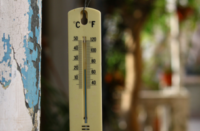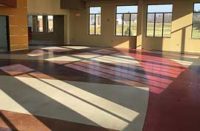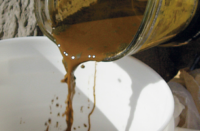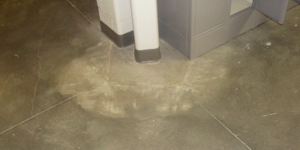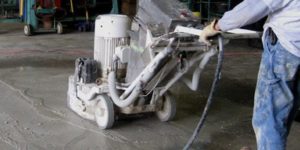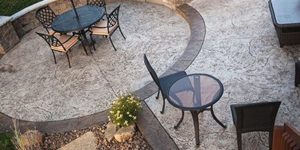
Toss it up, not out
Take half a handful and toss it straight up in the air, 4 or 5 feet from the ground. Let it open up and flutter down. It’s like confetti basically.
You just need to allow a little bit more time compared to a regular-flake floor because it takes a little bit longer. Because it’s such a light fluffy flake, it opens up like little parachutes and flutters down on the surface, so the time to flake it is actually a little bit longer than with a typical vinyl-chip floor.
You don’t want to throw out handfuls of it because you only get 10 pounds at a time in the container. If you treat it like a typical flake, if you grab it by the handful and try to throw it out over the surface and clump it together, realistically, you’re only going to get 150 square feet out of it. (Full coverage from 10 pounds should be anywhere from 450 to 500 square feet.)
Backroll it
What we prefer to do is work with the same rollers that we’re using for the epoxy, the 18-inch-rollers. They’ll have plastic covers and we leave them on the rollers and put them on the roller frame. The weight of the roller frame and roller will actually help push the flake or embed the flake into the epoxy as we backroll over the whole surface to push that flake down. You get full coverage on the floor, nothing is bleeding through and nothing gets on the actual roller to contaminate it.
You’re only rolling a thin coating of the epoxy. The way it dives into the concrete, Versatile Building Products’ 4195 is not like a typical epoxy, where you’ve got all of a sudden a thick-film build, and when the epoxy takes the flake, the flake sits on an edge and creates all these different crazy looks. The 4195 lays down flat so the chips have a tendency to lay down flat also.
Protect the area
We need to put plastic up about 4 feet high above the floor itself. The flake is so light that if it catches any wind it actually travels quite a bit. It creates a very fine powdered dust, especially when we’re sanding the surface. That dust is very difficult to get off the walls and everything, so there’s a lot more precautions needed in taping off the areas around the floor.
Also, we don’t want any wind blowing because the flake gets everywhere.
Clean, scrape, sand and vacuum
After we sweep the floor we’re going to scrape the floor — the flake over the epoxy — fairly aggressively. We’re not going to sweep it and recoup excess flake, because it breaks so easily into smaller particles.
Then we want to lightly sand the floor. That can be with a floor buffer machine or a palm sander or even just a pole sander they use for drywall. Either 120-grit sandpaper or 150-grit screen would be fine.
You need to vacuum the surface after that, too, because the residue becomes a powdery dust. You have to vacuum it at least once or twice.
Put two coats on top
We put two coats of sealer on our floor because even after you sand and put the first coat of primer down, if there’s anything sticking up on edge it becomes very sharp, and you end up with a rough-texture surface. So we apply our hybrid primer sealer first and then apply a topcoat of 5073 polyurea about 60 minutes later. The primer is a clear sealer — we use it as a primer but it can be used as a standalone sealer. It dries in about 60 minutes. Basically it gets two coats of sealer but we can get it done in one day.
It’s going to have a slight texture to it. You don’t want to make it too slippery.
